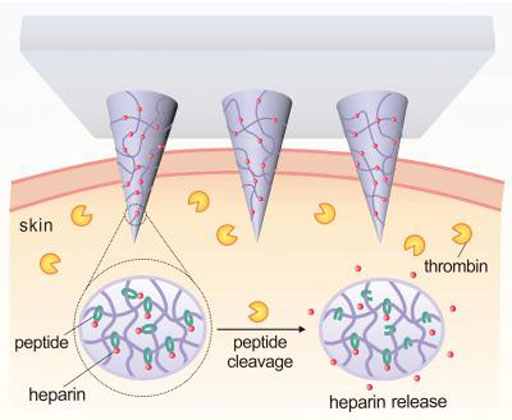Novel Smart Patch Prevents Fatal Blood Clots in Mouse Model
By Gerald M. Slutzky, PhD
Posted on 09 Dec 2016
Tests on a mouse model of thrombosis showed that a novel "smart patch" heparin delivery system prevented clotting efficiently in a feedback-controlled manner.Posted on 09 Dec 2016
An interdisciplinary team of researchers at North Carolina State University (Raleigh, USA) and the University of North Carolina (Chapel Hill, USA) had designed a smart patch comprising microneedles made of a polymer composed of hyaluronic acid (HA) and heparin.

Image: A diagram of thrombin-responsive patch that releases heparin in response to thrombin (Photo courtesy of Yuqi Zhang).
The polymer was designed to be responsive to thrombin, an enzyme that initiates clotting in the blood. Elevated levels of thrombin in the bloodstream dissolved the amino acid chains binding heparin to HA, releasing the heparin into the blood stream.
In a paper published in the November 25, 2016, online edition of the journal Advanced Materials, the investigators described testing the smart patch on mice. Mice were either left untreated, injected with heparin, or treated with the HA-heparin smart patch 10 minutes or six hours before being injected with a lethal dose of thrombin.
All of the mice with the HA-heparin smart patch survived both treatments. Mice injected with heparin survived the 10-minute exposure, but around 80% died after six hours. All the untreated mice were killed by both treatments.
"Our goal was to generate a patch that can monitor a patient's blood and release additional drugs when necessary; effectively, a self-regulating system," said senior author Dr. Zhen Gu, assistant professor in the joint biomedical engineering program at North Carolina State University and the University of North Carolina. "We are excited about the possibility of using a closed-loop, self-regulating smart patch to help treat a condition that affects thousands of people every year, while hopefully also driving down treatment costs. This paper represents a good first step, and we are now looking for funding to perform additional preclinical testing."
Related Links:
North Carolina State University
University of North Carolina




 assay.jpg)









